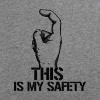westernrover
Member
- Joined
- May 4, 2018
- Messages
- 1,613
I've mostly been a double-action revolver guy, and a uncocked revolver action is normally considered safe simply because of the heavy trigger pull required to fire the gun provided it has a firing pin block or transfer bar, and otherwise there are some antiquated methods to provide drop safety and allow for safer decocking. The safety of a decocked DA/SA or DAO automatic is easy enough to interpolate. And a SAO automatic with a disconnect like the Series 80 1911 is also widely regarded as safe to carry when the safety is engaged, not because the trigger is heavy, but because firing requires two deliberate actions.
Why would any of the popular striker-fired actions be considered safer than a Series 80 with the safety off? Like the Glock, M&P 2.0, or P320. How would these actions be described anyway? Ok, so a spring acts directly on the firing pin to strike the primer instead of acting on a hammer that pivots about an axis or fulcrum to hit the primer, but the spring is primarily cocked or energized by the reward motion of the slide, so the trigger itself is essentially a SAO trigger, albeit it with some blocks and disconnects right?
I understand they have disconnects or blocks that make them drop-safe, so we might regard that issue as settled, but the triggers on these have been advertised or tested at as little as 5.5 or 6 pounds. Plenty of 1911's have trigger weights well over 5 pounds. So is carrying one of these just like carrying a Series 80 with a 6 pound trigger and the safety off?
Why would any of the popular striker-fired actions be considered safer than a Series 80 with the safety off? Like the Glock, M&P 2.0, or P320. How would these actions be described anyway? Ok, so a spring acts directly on the firing pin to strike the primer instead of acting on a hammer that pivots about an axis or fulcrum to hit the primer, but the spring is primarily cocked or energized by the reward motion of the slide, so the trigger itself is essentially a SAO trigger, albeit it with some blocks and disconnects right?
I understand they have disconnects or blocks that make them drop-safe, so we might regard that issue as settled, but the triggers on these have been advertised or tested at as little as 5.5 or 6 pounds. Plenty of 1911's have trigger weights well over 5 pounds. So is carrying one of these just like carrying a Series 80 with a 6 pound trigger and the safety off?



